IN THIS ISSUE
- A biologist's longleaf legacy
- Right whale sightings stir hope
- If you give a nuthatch a tool
- Wild ways you helped wildlife
- Tiny rattlesnake, cool salamanders
 Biologist Nathan Klaus honored for longleaf restoration involving Sprewell Bluff (Rick Lavender/DNR)
Just east of Manchester, a bumpy woods road of clay, sand and quartzite climbs to where the Pine Mountain ridgeline reaches for the sky before nose-diving into the Flint River. Hills roll to the horizon. Clouds drift dark shadows across them.
Nathan Klaus is taking it all in, navigating the road’s ruts, peering out his truck window and talking between clunks that wrench at the steering wheel. The senior DNR biologist points out stands of longleaf pines that wash dark green down slopes colored tan and sage with little bluestem and other grasses.
“Every longleaf you’re looking at in this area was saved,” he says.
Saved because when he learned that nearly 600 acres of the rumpled landscape would be clearcut, Klaus called the landowner to ask about sparing the longleaf. The answer: Put paint on whatever you want to keep. Klaus and fellow employees scurried to gather as many cans of spray paint as possible.
As they marked trees, logging equipment rumbled nearby.
Now part of the 6,500-acre Sprewell Bluff Wildlife Management Area, the area is testament to Klaus’ work with longleaf pine. It’s also part of the reason he was named The Longleaf Alliance’s Bill Boyer Natural Resource Professional of the Year. The nomination calls his efforts to help restore some 12,000 acres in and around the west Georgia WMA “a legacy project.”
Klaus, a 19-year DNR veteran, might call it seeing the big picture. …
Read about Nathan Klaus' efforts to restore longleaf habitats and rare wildlife.
Top
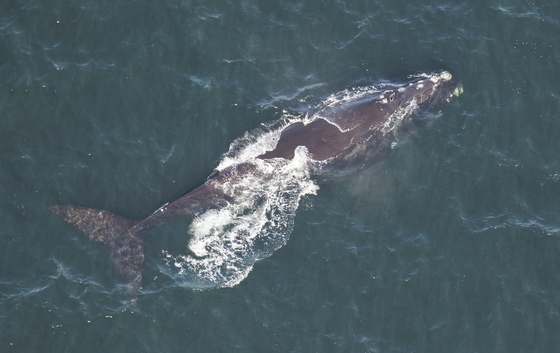 "Magnet" 20 miles southeast of Tybee Island (Sea to Shore Alliance, NOAA permit 20556-01)
Here’s hoping the rising count of adult female North Atlantic right whales off the Georgia coast is a sign of younger whales to come.
Sea to Shore Alliance, which surveys by plane for the endangered whales December through March, spotted females 2503 and 3808 – nicknamed Boomerang and Magnet – about 20 miles off Tybee Island a week ago. On Tuesday, three more adult females were seen off Ossabaw and Wassaw islands.
The identification and known history of the last three whales was not immediately available. But scientists know that Boomerang is 23 years old and last had a calf in 2014. Magnet has not calved, but at 10 could be pregnant.
The calf watch off Georgia and north Florida, the species’ only known calving grounds, has been intensified by the dwindling number of North Atlantic right whales – down to the low 400s – and the fact no calves were seen last winter, a first since comprehensive aerial surveys began in the 1980s ("Bleak winter," April 10).
The double-barreled decline is tied to two issues, according to DNR senior wildlife biologist Clay George.
One, right whales are suffering and dying from entanglement in commercial fishing rope, primarily from lobster, crab and other pot fisheries in New England and Canada. Two, because of climate-related changes in plankton food resources, whales are shifting from summer feeding areas in the Gulf of Maine farther north into Canada to feed, a move that requires more time for females to replenish fat reserves.
Fewer healthy, reproductive-age females means fewer calves. Which means fewer right whales.
Which means the potential moms seen off Georgia’s coast are even more critical for the survival of North Atlantic right whales.
ENTANGLED
- More than 80 percent of right whales have been entangled in commercial fishing rope (video).
- In 2017, seven were found dead from rope entanglements.
- In the works: rope-less pots released by acoustic signal, ropes that break easier to reduce whale injuries and possible development of “whale-safe” lobster.
FOR MORE
Top
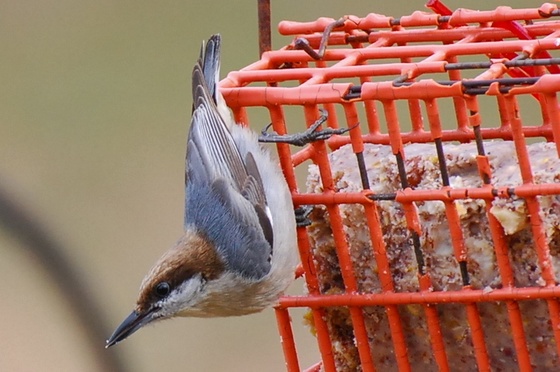 Brown-headed nuthatch (Terry W. Johnson)
By TERRY W. JOHNSON
In the not too distant past, humans were considered the only animals that used tools. However, biologists throughout the world have discovered that an amazing array of wildlife, from mammals and fish to birds, insects and even cephalopods (e.g., octopus) all make use of tools.
Most ornithologists believe that of the some 9,000 to 10,000 species of birds in the world, only 270 species use tools. And only one in North America regularly does so.
Fortunately, this remarkable creature also is a resident of backyards throughout Georgia. That would be the brown-headed nuthatch. …
Read the rest of Terry’s column to learn what these birds use as tools and how.
Terry W. Johnson is a retired DNR wildlife conservation program manager and executive director of TERN, the Wildlife Conservation Section’s friends group. Read more columns, Terry’s Backyard Wildlife Connection blog and his book “A Journey of Discovery: Monroe County Outdoors.” (Permission required to use this column.)
Red-breasted nuthatch (Linda May/DNR)
NUTHATCH IRRUPTION
While on the subject of nuthatches, Georgians have been hearing and seeing more red-breasted nuthatches because of an Atlantic Coast irruption of the species.
Irruption, in reference to birds, is when large numbers of a species migrate farther south than normal. According to Audubon, the likely reason for the red-breasted nuthatch invasion this year is a lack of spruce seeds in the bird’s winter range.
Top
 Nesting loggerhead on Sea Island (Haley Watkins/Sea Island)
Usually the headline for this section reads “What you can do.”
It's where the newsletter highlights the importance of public support for conserving Georgia’s rare and other wildlife, and how things such as renewing an eagle or hummingbird license plate are key to that support.
However, lately Georgia Wild has been hearing about readers’ actions that range outside these how-to-help tips. Stories such as ...
Ladyslipper rescue II: A hunter who is a regular at John’s Mountain Wildlife Management Area didn't realize the pink-flowering plants he enjoyed seeing at the WMA near Calhoun were an unusual lily. Until he read last month’s article about a Lumpkin County landowner helping rescue pink ladyslippers.
Interested in protecting the pink ladyslippers at Johns Mountain, the man reported the sites to DNR. They have been added to the rare species database kept by the agency’s Wildlife Conservation Section and will be plugged into land management.
A kitchen-sink snake: Another article in the November Georgia Wild encouraged readers to not overreact if they find a snake in the house. Bradford Swann, who grew up in middle Georgia, said the information “came in real handy” when he discovered an 18-inch rat snake in the kitchen sink of his Greenville, S.C., home.
Swann writes that thanks to the newsletter and a long pair of kitchen tongs (his emphasis), the snake was returned to the yard "in hopes he finds someone else’s house to spend the winter.”
Adopted sea turtle nests: Sea Island Resort’s Adopt a Sea Turtle Nest program contributed an amazing $10,550 to the Georgia Nongame Wildlife Conservation Fund this year. All 70 loggerhead sea turtle nests on the island this summer were adopted for $150 each, some as gifts for Mother's Day and birthdays.
Patrons received certificates, name markers on nests and an invite to join Sea Island naturalists when a nest is inventoried after hatching. More importantly, supporters helped continue the recovery of loggerheads, a federally listed species.
ALSO HOW TO HELP
Interested in other ways to help ensure Georgia’s rich range of wildlife is here for generations to enjoy? Check out DNR’s wildlife license plates and donation options.
We couldn't resist.
Top
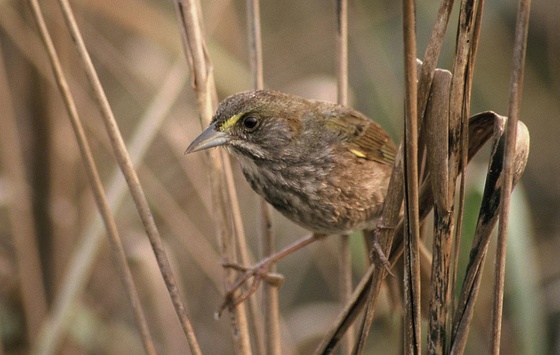 MacGillivray’s seaside sparrow (Todd Schneider/DNR)
Four Southeastern species – three found in Georgia – do not need protection under the Endangered Species Act, the U.S. Fish and Wildlife Service announced this week. In part because of conservation partnerships, populations of MacGillivray’s seaside sparrow, Florida sandhill crane and striped newt are stable or improving, threats have been addressed or lessened, and protections are in place, the service said, citing the same for Cedar Key mole skink, a reptile known to occur on only eight islands in Florida’s Cedar Keys.
Two new members of DNR Wildlife Conservation Section’s botany crew recently discovered two new sites for pond spice at a south Georgia wildlife management area. As part of their work monitoring sandhills restoration across the Coastal Plain, Morgan Bettcher and Melanie Flood found Georgia-rare Litsea aestivalis – an indicator of high-quality wetlands – in an open, grassy pond.
Twelve young gopher tortoises toting radio transmitters have been released in a head-starting project at Yuchi Wildlife Management Area near Waynesboro. The University of Georgia Savannah River Ecology Lab will release another 24 tortoises – most sans transmitters – this spring as part of the long-running project ("Help for Yuchi tortoises," June 18, 2015).
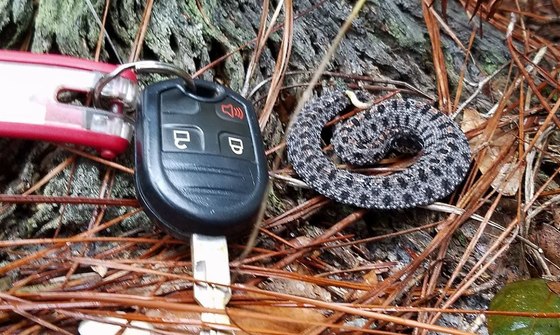 Pocket-sized pygmy rattler (DNR)
With adults rarely topping 2 feet, pigmy rattlesnakes are the smallest rattler. But the young pigmy (above) spotted by DNR's gopher tortoise crew in Camden County took tiny to a new level of small, while also showing the worm-like, yellow-tipped tail this species' babies wriggle as a caudal lure to attract prey such as frogs and lizards.
DNR’s Jason Lee and Steve Friedman were part of the group recently honored by the U.S. Forest Service for the Altamaha River Conservation Project. The effort involving the service’s Forest Legacy Program was given the Delivering State and Private Forestry Programs Group Award (photos). Lee is program manager of the Wildlife Conservation Section’s coastal office; Friedman is DNR Real Estate chief.
The Wildlife Viewing Grants Program is again seeking proposals for projects that need a hand helping Georgians enjoy and better understand animals, plants and habitats emphasized in Georgia’s State Wildlife Action Plan. Feb. 1 is the deadline to apply for the DNR grants of up to $3,000 each.
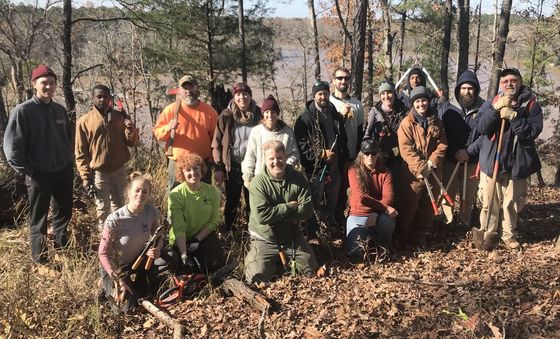 Dwarf sumac work crew at Lower Broad River (Gabe Musgraves/Zoo Atlanta)
Dwarf sumac benefited from a Georgia Plant Conservation Alliance workday to remove competing vegetation at Lower Broad River Wildlife Management Area, home to one of the state’s two naturally occurring populations of the endangered plant. The work led by DNR’s Dr. Mincy J. Moffett Jr. fielded 17 volunteers from five organizations at the WMA near Elberton.
Youth who want to learn about birding have a second chance to sign up for DNR’s Youth Christmas Bird Count at Charlie Elliott Wildlife Center. Rain postponed the original event to Jan. 12, which means ages 8-16 can make – and keep – a New Year’s resolution to try birding, complete with guides and lunch at no cost.
A new online database of scientific records and photos features more than 400 native fishes in Georgia and seven other states. Launched by the Tennessee Aquarium Conservation Institute, the Freshwater Information Network, long for FIN, has been dubbed “Facebook for fish” (video).
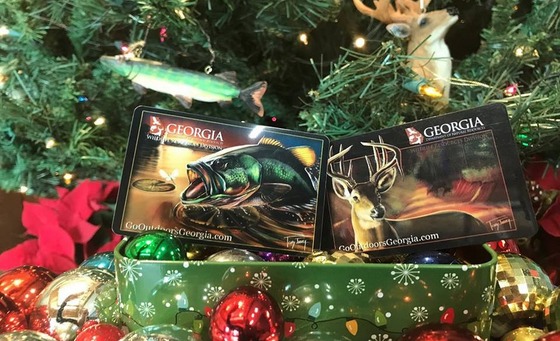 This holiday season, why not give the wildlife enthusiast on your list a “license” to keep enjoying Georgia’s wildlife and wild places? Hunting and fishing licenses not only offer access to the outdoors, they provide crucial support to states for managing wildlife and wildlife management areas. Purchase a license.
Names in the news: The Board of Natural Resources has approved DNR Commissioner Mark Williams’ appointment of Thomas Barnard as Law Enforcement Division colonel and director. A 25-year DNR veteran and former field operations major, Barnard succeeds Col. Eddie Henderson, who retired in November. Robert Ramsay has stepped down as Georgia Conservancy president. Having led the conservancy since 2014 and helping promote passage of the Georgia Outdoor Stewardship Amendment this year, Ramsay accepted an executive director position with a national conservation organization. Leopoldo “Leo” Miranda will head the U.S. Fish and Wildlife Service’s Southeast Region, covering 10 Southeastern states, Puerto Rico and the U.S. Virgin Islands. Miranda, formerly an assistant regional director in the Atlanta office, fills the vacancy left by Cindy Dohner’s retirement in 2017. DNR senior wildlife biologist John Jensen authored with six others a paper exploring how landscape factors such as distance drive genetic divergences in slimy salamander populations. The study is published in Canadian Journal of Zoology.
COMING UP
Jan. 7 – “Journey of the whooping crane" premiere, Covey Film Festival, 7 p.m., Thomas University, Thomasville
Jan. 14 – Deadline to submit abstracts to Georgia Adopt-A-Stream Water Science Poster Session. (Finalists will present at Confluence, Adopt-A-Stream conference, March 22-24.)
Jan. 26 – Flatwoods Fire and Nature Festival, 10 a.m.-3 p.m., Austin Cary Memorial Forest, Gainesville, Fla.
Feb. 15-16 – 2019 Weekend for Wildlife (DNR wildlife conservation fundraiser), Sea Island
March 22-24 – Confluence (Georgia Adopt-A-Stream volunteer water-quality monitoring conference), Unicoi State Park and Lodge, Helen
WHAT YOU MISSED …
In the previous Georgia Wild:
- Snakes in close quarters
- Landowner spurs plant rescue
- The "why" behind white squirrels
Top
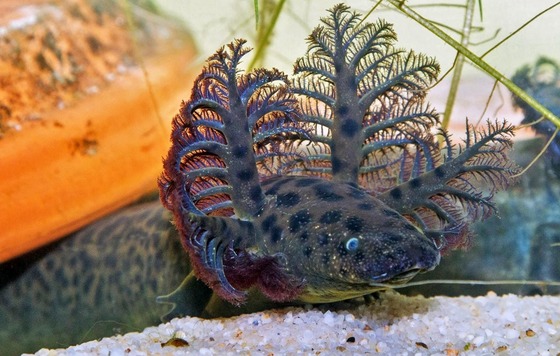 Reticulated siren (Pierson Hill)
"Salamander of legend emerges from southern swamps," The New York Times. Published paper (PLOS One).
"Right whales return to Tybee; wait on for babies," Savannah Morning News. Also: "Half of world’s North Atlantic right whales seen in Gulf of St. Lawrence in 2018," Global News. "Right whales arrive earlier in Cape Cod Bay," WBZ-TV (4, Boston)
"State grants available for projects to help people view wildlife," SaportaReport
"After Hurricane Michael," U.S. Fish and Wildlife Service. Also: "Test flight for red-cockaded woodpeckers" (+video).
"Work continues to save venerable gopher tortoise," Savannah Morning News. Also: "Elusive rainbow snake an expert eel predator."
"Artist, DNR biologist finds inspiration in nature," The Brunswick News
"Robust redhorse in the Ocmulgee," Georgia Adopt-A-Stream
"Gov. tees up $200 million for south Georgia growers," The Moultrie Observer
"New, deadly tick could be headed for Georgia," Atlanta Journal-Constitution
"DNR seizes venomous vipers, cobra at Jackson home," Athens Banner-Herald
"The insect apocalypse is here," The New York Times Magazine
"One-in-a-million yellow cardinal spotted in Georgia," Southern Living
"68-year-old bird has laid yet another egg," Smithsonian
"Customs finds 70 live finches hidden in passenger's hair rollers," Thrillist
"Tiny Florida butterfly refuses to become extinct," Atlas Obscura
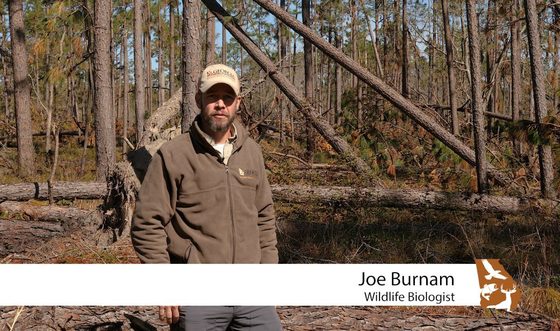 VIDEO AND AUDIO
"Hurricane Michael vs. red-cockaded woodpeckers in southwest Georgia," DNR
(audio) "Search for giant, rare salamanders in Georgia," WABE-FM (90.1, Atlanta)
"Longleaf pine restoration damaged by Michael," WALB-TV (10, Albany)
Top
 A unique-patterned tiger salamander in Bartow County (Greg Brashear)
A tiger never changes its stripes? This tiger salamander at least has stripes of a different color. The species’ normal pattern is a black background with lighter blotches. This breeding-condition male, found by Greg Brashear in Bartow County, is almost the reverse, with dark stripes and a dorsal and ventral with little black patterning. “Certainly a looker,” Brashear writes. He notes that other tiger salamanders in the area are usually black with yellow and gold spots or blotches. Tigers are the Southeast’s largest terrestrial salamander, reaching 8 inches long.
Masthead: northern cardinal at feeder (Josiah Lavender)
Top
|